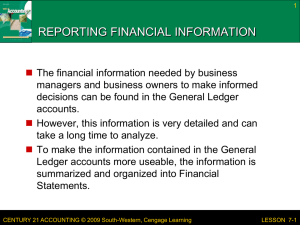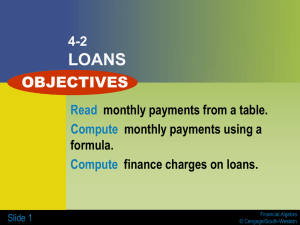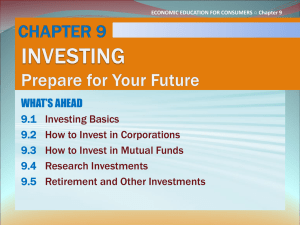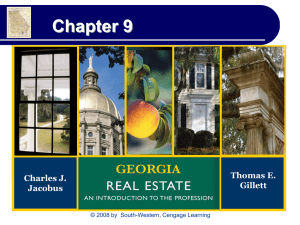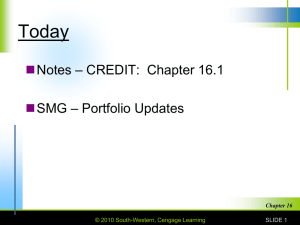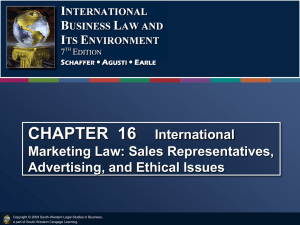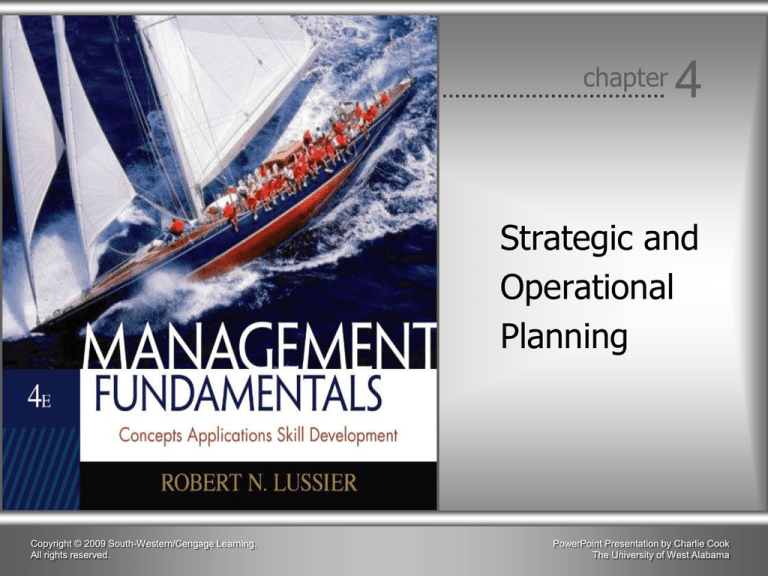
chapter
4
Strategic and
Operational
Planning
Copyright © 2009 South-Western/Cengage Learning.
All rights reserved.
PowerPoint Presentation by Charlie Cook
The University of West Alabama
Strategic versus Operational Planning
• Strategic Planning
The process of developing a mission and long-range
objectives and determining in advance how they will
be accomplished.
• Operational Planning
The process of setting short-range objectives and
determining in advance how they will be
accomplished.
• Strategy
A plan for pursuing the mission and achieving
objectives.
Copyright © 2009 South-Western/Cengage Learning. All rights reserved.
4–2
Exhibit 4–1 ● Planning Dimensions
Copyright © 2009 South-Western/Cengage Learning. All rights reserved.
4–3
Strategic Planning Strategies
• Corporate Strategy
The plan for managing multiple lines of businesses.
• Business Strategy
The plan for managing one line of business.
• Functional Strategy
The plan for managing one area of a business.
Copyright © 2009 South-Western/Cengage Learning. All rights reserved.
4–4
Exhibit 4–3 ● The Strategic Planning Process
Copyright © 2009 South-Western/Cengage Learning. All rights reserved.
4–5
Exhibit 4–4 ● Starbucks’s Five-Force Competitive Analysis
Copyright © 2009 South-Western/Cengage Learning. All rights reserved.
4–6
Exhibit 4–6 ● SWOT Analysis for Starbucks Coffee
Copyright © 2009 South-Western/Cengage Learning. All rights reserved.
4–7
Goals and Objectives
• Goals
Are general, broad targets to be accomplished that
are translated into actionable objectives.
• Objectives
State what is to be accomplished in singular, specific,
and measurable terms with a target date.
Copyright © 2009 South-Western/Cengage Learning. All rights reserved.
4–8
Writing Effective Objectives
• Max E. Douglas’s Model for Writing Effective
Objectives:
1. The word to followed by
2. an action verb;
3. a statement of the single, specific, and measurable
result to be achieved; and
4. a target date.
• Example:
To achieve a 6% overall return on fourth quarter
sales.
Copyright © 2009 South-Western/Cengage Learning. All rights reserved.
4–9
Copyright © 2009 South-Western/Cengage Learning. All rights reserved.
4–10
Management by Objectives (MBO)
• Three Steps:
Step 1. Set individual objectives and plans.
Step 2. Give feedback and evaluate performance.
Step 3. Reward according to performance.
• Sources of MBO Failures
Lack of top management commitment and follow-
through on MBO.
Employees’ negative beliefs about management’s
sincerity in its efforts to include them in the decisionmaking process.
Copyright © 2009 South-Western/Cengage Learning. All rights reserved.
4–11
Corporate Strategies
• Grand Strategies
Growth
The company makes aggressive attempts to increase its size
through increased sales.
Stability
The company attempts to hold and maintain its present size
or to grow slowly.
Turnaround and retrenchment
An attempt to reverse a declining business as quickly as
possible.
The divestiture or liquidation of assets.
Combination
A corporation may pursue growth, stability, and turnaround
and retrenchment for its different lines of business or areas
of operations.
Copyright © 2009 South-Western/Cengage Learning. All rights reserved.
4–12
Corporate Strategies (cont’d)
• Growth Strategies
Concentration
The organization grows aggressively in its existing line(s) of
business.
Integration
The organization enters a new line or lines of business
related to its existing one(s).
Diversification
The organization goes into a related (concentric
diversification) or unrelated (conglomerate diversification)
line of products.
Copyright © 2009 South-Western/Cengage Learning. All rights reserved.
4–13
Exhibit 4–9 ● Grand and Growth Strategies
Grand Strategy
Growth
Stability
(aggressively
expand size)
(remain the same
or grow slowly)
Turnaround and
Retrenchment
(reverse a negative
trend and cut back))
Combination
(mix of other three)
Growth Strategies
Concentration—expand existing line(s) of business
Integration—expand forward and/or backward within line(s) of business
Diversification—add related and/or unrelated products
Copyright © 2009 South-Western/Cengage Learning. All rights reserved.
4–14
Common Methods for Pursuing a Growth Strategy
Mergers
Strategic Alliances
Joint Ventures
Copyright © 2009 South-Western/Cengage Learning. All rights reserved.
Acquisitions
Takeovers
4–15
Copyright © 2009 South-Western/Cengage Learning. All rights reserved.
4–16
Exhibit 4–10 ● BCG Growth-Share Matrix
Copyright © 2009 South-Western/Cengage Learning. All rights reserved.
4–17
Exhibit 4–11 ● The Entrepreneurial Strategy Matrix (ESM)
Source: Reprinted from Business Horizons, Volume 40 (3), Matthew C. Sonfield and Robert
N. Lussier, “The Entrepreneurial Strategy Matrix. A Model for New and Ongoing Ventures,”
Copyright ©1997, with permission from Elsevier..
Copyright © 2009 South-Western/Cengage Learning. All rights reserved.
4–18
Business Strategies
• Adaptive Strategies
Prospecting
Aggressively offering new products and/or entering new
markets.
Defending
Staying with the present product line and markets and
maintaining or increasing customers.
Analyzing
A midrange approach between prospecting and defending,
moving cautiously into new markets.
Copyright © 2009 South-Western/Cengage Learning. All rights reserved.
4–19
Exhibit 4–12 ● Adaptive Strategies
Copyright © 2009 South-Western/Cengage Learning. All rights reserved.
4–20
Copyright © 2009 South-Western/Cengage Learning. All rights reserved.
4–21
Exhibit 4–13 ● Strategies for Starbucks over the Product Life Cycle
Copyright © 2009 South-Western/Cengage Learning. All rights reserved.
4–22
Copyright © 2009 South-Western/Cengage Learning. All rights reserved.
4–23
Functional Strategies
• Marketing Strategy
Responsible for determining which products to
provide, how they will be packaged, how they will be
advertised, where they will be sold and how they will
get there, and how much they will be sold for.
• Operations Strategy
Responsible for systems processes that convert
inputs into outputs.
• Human Resources Strategy
Responsible for working with all the other functional
departments in the areas of recruiting, selecting,
training, evaluating, and compensating employees.
Copyright © 2009 South-Western/Cengage Learning. All rights reserved.
4–24
Functional Strategies (cont’d)
• Finance Strategy
Responsible for financing the business activities by
raising money through the sale of stock or bonds or
through loans, deciding on the debt-to-equity ratio,
paying off the debt and dividends to shareholders,
keeping records of transactions, developing budgets,
and reporting financial results.
• Other Functional Strategies
Research and development (R&D) is important to
remaining competitive.
Copyright © 2009 South-Western/Cengage Learning. All rights reserved.
4–25
Exhibit 4–14 ● Standing Plans versus Single-Use Plans
Copyright © 2009 South-Western/Cengage Learning. All rights reserved.
4–26
Types of Plans
• Standing Plans
Policies, procedures, and rules developed for
handling repetitive situations.
Policies
General guidelines to be followed when making decisions.
Procedures
A sequence of actions to be followed in order to achieve an
objective.
Rules
A statement of exactly what should or should not be done.
Copyright © 2009 South-Western/Cengage Learning. All rights reserved.
4–27
Types of Plans (cont’d)
• Single-Use Plans
Programs and budgets developed for handling
nonrepetitive situations.
Program
A set of activities designed to accomplish an objective over
a specified period of time.
Program development:
1.
2.
3.
4.
5.
Set project objectives.
Break the project down into a sequence of steps.
Assign responsibility for each step.
Establish starting and ending times for each step.
Determine the resources needed for each step.
Copyright © 2009 South-Western/Cengage Learning. All rights reserved.
4–28
Types of Plans (cont’d)
• Single-Use Plans (cont’d)
Budget
Represents the funds allocated to operate a unit for a fixed
period of time.
Is a planning tool initially and becomes a control tool after
implementation of the plan.
Copyright © 2009 South-Western/Cengage Learning. All rights reserved.
4–29
Copyright © 2009 South-Western/Cengage Learning. All rights reserved.
4–30
Types of Plans (cont’d)
• Contingency Plans
Alternative plans to be implemented if uncontrollable
events occur.
Three questions to answer for developing a
contingency plan:
1. What might go wrong?
2. How can I prevent it from happening?
3. If it does occur, what can I do to minimize its effect?
Copyright © 2009 South-Western/Cengage Learning. All rights reserved.
4–31
Implementing and Controlling Strategies
• Implementing
Top and middle managers plan, whereas lower-level
functional managers and employees implement the
strategies that make up the plan.
Successful implementation requires effective and
efficient support systems.
• Controlling
The process of establishing and implementing
mechanisms to ensure that objectives are achieved.
Measuring progress toward the achievement of objectives
and taking corrective action when needed.
Staying within the budget when appropriate or changing it
when necessary to meet changes in the environment.
Copyright © 2009 South-Western/Cengage Learning. All rights reserved.
4–32

